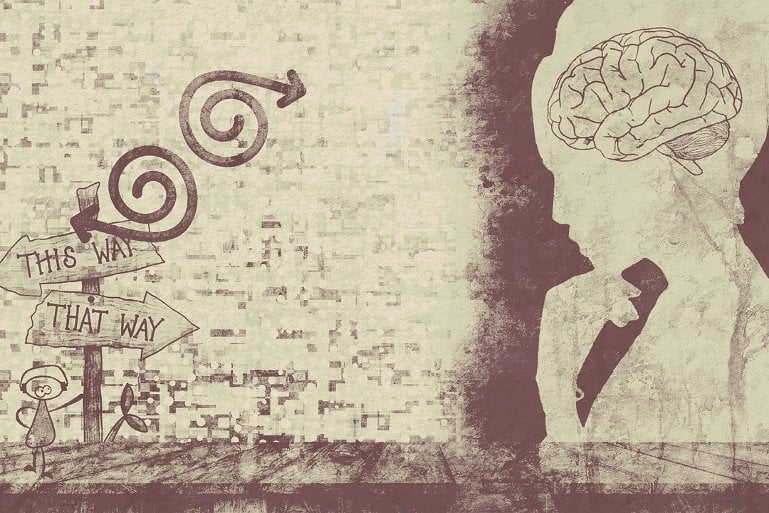Summary: When it comes to decision-making, rather than committing to a single strategy, the brain computes multiple decision strategies simultaneously.
Source: Champalimaud Centre for the Unknown
Choosing a checkout line in a supermarket might seem like a no-brainer, but it can actually involve a complex series of cerebral computations. Maybe you count the number of shoppers in each line and pick the shortest, or estimate the number of items on each conveyor belt. Perhaps you quickly weigh up both shoppers and items and maybe even the apparent speed of the cashier… In fact, there are a multiplicity of strategies for solving this problem.
So how does the brain know how to make decisions in situations like this where there are multiple possible strategies to choose from?
A study published today, April 13th, in the journal Nature Neuroscience provides a surprising answer to this question by showing that, rather than committing to a single strategy, the brain can compute multiple alternative decision strategies simultaneously.
The study, led by Fanny Cazettes and senior authors Zachary Mainen and Alfonso Renart, at the Champalimaud Foundation in Lisbon, Portugal, performed a specially-designed experiment which used a kind of “virtual reality” setup for mice, in which the animals were tasked with searching for water in a virtual world.
Specifically, the authors’ designed a “virtual mouse world” containing the kind of foraging problem that animal brains have evolved to be good at, allowing them to study the complex decision strategies used by mice.
Any given location in the virtual world could provide water unreliably and, at some point, would “dry up” and cease giving water altogether. The mice had to decide when to leave a given location and move to another in search of more water.
To solve the task optimally, the best strategy would be for the mice to learn to count the number of consecutive missed attempts to get water at a given site, and to switch locations when the number of consecutive misses was sufficiently large.
But there were multiple alternative strategies for processing the series of successful and unsuccessful tries, including, for instance, calculating the difference between the number of successful and unsuccessful attempts.
Each strategy combines misses and successful tries across time in a particular way, and thus has a signature time course – which is called the “decision variable” – that can be matched against the time course of brain activity patterns.
The researchers recorded activity from large ensembles of individual brain cells in a part of the brain known as the premotor cortex while the mice performed the task. They then looked for combinations of the temporal profiles of activity of recorded premotor neurons which resembled the decision variables associated with the different strategies.
To the authors’ surprise, data showed that, while each mouse focused on their own strategy, their brains did not.
Fanny Cazettes explains, “We found that, while activity in the premotor cortex reflected the computation that the mouse was actually using, it also reflected alternative decision variables useful for the same task, and even decision variables useful for other tasks.”
Zach Mainen, one of the study’s senior authors, adds that, “Contrary to our experience in checkout lines, we found that the brain can actually perform several different counting strategies at the same time, which is reminiscent of the concept of superposition in quantum mechanics.”
Although there is still much to be explored in this area, this study provides an important foundation for future research.
“Our findings suggest the need for new ways of thinking about the core processes involved in decision-making and action selection. One of our next steps will be to investigate how the brain selects between different decision variables and how these decisions are translated into action”, says Fanny Cazettes.

What could be the usefulness of representing both used and unused strategies simultaneously?
“This arrangement might facilitate cognitive flexibility and learning, because changing strategies only requires attending to the right precomputed decision variable, rather than having to construct it from scratch”, argues Alfonso Renart, the other senior author.
“These findings have important implications for our understanding of how the brain processes and selects decision variables in complex environments. There could be implications for the development of more flexible and adaptable machine learning systems, which might be particularly useful in situations where there is a high degree of uncertainty or complexity”, concludes Zach Mainen.
About this neuroscience research news
Author: Ana Gerschenfeld
Source: Champalimaud Centre for the Unknown
Contact: Ana Gerschenfeld – Champalimaud Centre for the Unknown
Image: The image is in the public domain
Original Research: Closed access.
“A reservoir of foraging decision variables in the mouse brain” by Fanny Cazettes et al. Nature Neuroscience
Abstract
A reservoir of foraging decision variables in the mouse brain
In any given situation, the environment can be parsed in different ways to yield decision variables (DVs) defining strategies useful for different tasks. It is generally presumed that the brain only computes a single DV defining the current behavioral strategy.
Here to test this assumption, we recorded neural ensembles in the frontal cortex of mice performing a foraging task admitting multiple DVs. Methods developed to uncover the currently employed DV revealed the use of multiple strategies and occasional switches in strategy within sessions.
Optogenetic manipulations showed that the secondary motor cortex (M2) is needed for mice to use the different DVs in the task. Surprisingly, we found that regardless of which DV best explained the current behavior, M2 activity concurrently encoded a full basis set of computations defining a reservoir of DVs appropriate for alternative tasks.
This form of neural multiplexing may confer considerable advantages for learning and adaptive behavior.






